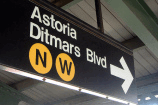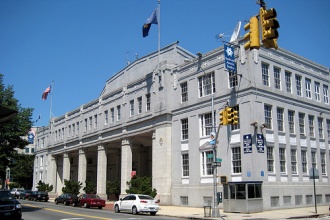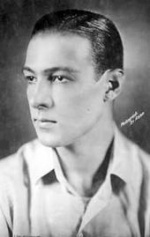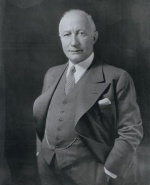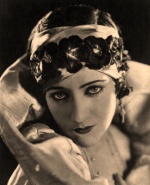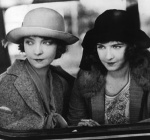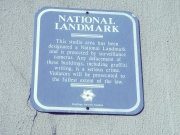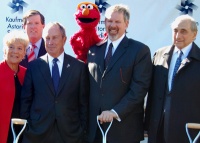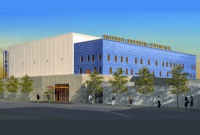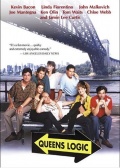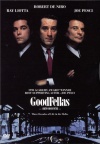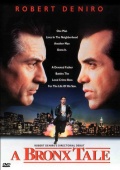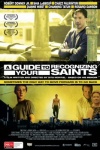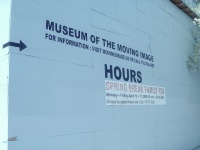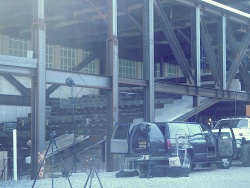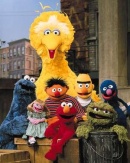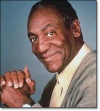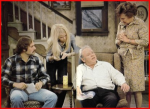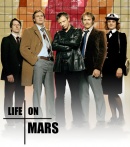| wiki | search |
Home
| Population Trends
| Gentrification
| Culinary Demography
| Architecture
Houses of Worship
| Art in Astoria
| Film Industry
| Steinway
| Index
| Contributors
Starting in the 1920s, Astoria became a popular site for filmmakers. From then to now, the area has seen a lot of change pertaining to this industry. The use of Kaufman Astoria Studios stands as a testament.
Kaufman Astoria Studios
Located on 34th avenue and 36th street in Astoria, Queens is the renown Kaufman Astoria Studios, New York’s premier film and television product complex. KAS is the center of a creative environment where shooting, pre-production, and post-production take place around the clock. KAS offers producers, directors, and other industry professionals over 500,000 square feet of office and service space.[1]
Kaufman Astoria Studios currently has six versatile stages, ranging from 3,000 to 12,000 square feet of space, in addition to a 26,000 square foot stage, the largest east of Hollywood.[2]
KAS Music and Sound is a full-service recording studio within the complex. The staff of musicians provides an array of services from single lead sheets to full orchestral arrangements. Other services offered include: mixing and mastering, ADR, lock-to-picture voice-over, full baking transferring and archiving, and connectivity to the KAS soundstages.[3]
Some recent clients of KAS Music and Sound include: Billy Joel, 'N Sync, Placido Domingo, R.E.M., Keith Richards, Tony Bennett, Dizzy Gillespie, Carly Simon, Wynton Marsalis, Art Garfunkel, Jennifer Hudson, Alicia Keys.[3]
History of Kaufman Studios
The legendary film mogul Adolph Zuckor originally opened Astoria Studios in 1920 for the Famous Players Film Company, which evolved into Famous Players-Lasky and then Paramount Pictures, of which he served as president until his death in 1936. Over 100 films were produced at Astoria during the twenties. At this time, New York was the center of the fledgling film industry, and Astoria was the Mecca of the Silent Era. Astoria Studios was the center for production, with its main stage and basement stages; it could hold up to six feature films in production at any time. Astoria Studios was where the moving picture industry actually developed; and was home to talented actors such as Academy Award-nominated, Golden Globe-winning American actress Gloria Swanson, sisters Dorothy and Lillian Gish (Dorothy would go on to star in over 100 short films and features, many of them with Lillian; Lillian was named 17th among the greatest female stars of all time by the American Film Institute), and Rudolph Valentino, known as one of the most popular stars of the 1920s, and one of the most recognized stars from the silent film era. Essentially, it was here where many breakout stars had the opportunity to develop and display their talent.[4]
The arrival of “talkies,” films which include dialogue, music, and other forms of sound, production at Astoria boomed. Although today the majority of films are talkies, when “talking films” were introduced they attracted a great amount of attention and public commentary. “Talkies” also reshaped the technology used in the motion picture industry, such as recording and play back audio equipment. As a result, talented writers and actors rushed to Astoria, and the Studio made huge profits.[5]
The first all talking feature film shot at the studio The Letter, received an Oscar nomination for actress Jeanne Eagels. The talking film debuts of Claudette Colbert, Edward G. Robinson and Tallulah Bankhead were filmed here. The Marx Brothers moved from Broadway to the silver screen in Astoria to produce their first two films, The Cocoanuts (1929) and Animal Crackers (1930).[6]
Around the end of this period, the film industry began to move to Hollywood. In 1942, during the start of World War II, the United States Army Signal Corps Army Pictorial Service took over the studio for the making of Army training and indoctrination films, and at this time the studio was during called the Army Pictorial Center. In 1970 the Studio was declared surplus property by the Army and turned over to the Federal Government. [7]
In 1982 the title to the Studio was transferred to the City of New York, and in 1982 real estate developer George S. Kaufman in partnership with Alan King, Johnny Carson and others, obtained the lease from the City. Kaufman renovated and expanded it into a comprehensive studio capable of handling any type, size and style of production. [7] George-kaufman.jpg Kaufman Astoria Studios has had a long track record of success, and has been the location for major motion pictures including: The Wiz, The Warrios, All That Jazz, Arthur, Ragtime, Hair, Brighton Beach Memoirs, Radio Days, Money Pit, Ishtar, Fletch Lives, Glengarry Glen Ross, Scent of a Woman, Age of Innocence, and Carlito's Way.[8]
Kaufman Astoria Studios Expansion & Tax Breaks
Kaufman Astoria Studios is finally moving ahead with an expansion plan. The groundbreaking began in fall 2008 for the $20 million building with an 18,000-square-foot soundstage, and 22,000-square feet of support space, located across 36th street between 34th and 35th avenues. The 40,000-square-foot studio will be designed like studio compounds with “backlots” found in major West Coast motion picture studios. Construction of the new studio, expected to be completed in summer 2009, is estimated to create 400 new independent production-related jobs through film or television production companies leasing space within the studio.[9]
“The importance of diversifying our economy is more obvious today than ever, and continued investments in New York City’s entertainment industry is one of the ways we’ve been doing it…we’ve seen a 92 percent increase in shooting days since 2002, and today our film and television production industry generates $5 billion a year in economic activity and supports 100,000 jobs” said Mayor Bloomberg at the groundbreaking ceremony.[10]
The expansion of the film industry in Astoria is not limited to Kaufman Astoria Studios. In fact, two years ago Silvercup Studios in Long Island City, announced it would build a $1 billion complex on the East River waterfront. It is to have eight new soundstages, production and support space, two towers with 1,000 apartments, an office tower and stores. These efforts are supported by many to help stimulate the economy and make Queens the desirable filming hotspot it once was.[11]
To further attract prospective clients to New York City and away from cheaper locations such as Canada and other states, the New York State Legislature approved a 10 percent tax credit on certain production costs, primarily for blue-collar technicians and crew members, and a 5 percent credit from New York City. Despite its proximity, a 10-minute subway ride from Manhattan, the 500,000 square-foot Kaufman Astoria Studios building has been suffering from the economy and filming budget cuts. However, these tax breaks — which are applied toward state and city income taxes — were further sweetened in April, when the Legislature tripled the state tax incentive to 30%.[9]
Some critics include E.J. McMahon, the director of the Manhattan Institute's Empire Center for New York State Policy. Mr. McMahon has said he had no doubt the credits were increasing filmmaking in the city and state, but the benefit of these credits was unclear. “If you are subsidizing somebody to do something, they will do more of it," Mr. McMahon said. "The question is: is it worth it?" Production companies are coming to New York in such numbers that all three of the city's largest studio owners, Kaufman Astoria, Steiner, and Silvercup, are building more facilities.[12] "The tax credit narrowed the gap," the president of Kaufman Astoria Studios, Hal Rosenbluth, said. "Before the tax credit, we were losing projects to other parts of the world and the country. Now, we are all very busy."[12] However, some industry experts still warn that shows already are fleeing to other cities where similar credits are available. For example, the Fox series "Fringe" announced plans to move its production out of the city.
Nonetheless, the state and the city are on track to collect about $2.7 billion in taxes between 2004 and 2009 from the film and TV industry, according to a study by Ernst and Young. The industry also created 7,031 jobs directly and more than 12,000 indirectly, the study showed.[10]
Government officials and film industry observers generally laud Astoria Studios’ expansion plans: “There is a growing competitive awareness that the space you are offering for TV and film production needs to be upgraded in quantity and upgraded in quality,” said Rosemary Scanlon, associate professor of economics at the Real Estate Institute of New York University. Ms. Scanlon estimates that television and film production is responsible for $6.6 billion of the total $21.2 billion generated by the arts in New York’s economy. [11]
Deputy Mayor Lieber also supports this project stating, “our efforts to grow New York City’s film and television production industry have led to genuine gains in entertainment-related jobs and economic activity and the demand for more studio space…The expansion of Kaufman Astoria Studios will help meet that demand.” [9] Michael N. Gianaris, a Democratic state assemblyman from Queens, predicted the new development would be “an integral part of the continued success of Long Island City and Astoria. It’s an area of the city growing by leaps and bounds; many of us believe it will be the next big business district for the city.”[10]
In 2002, Mayor Bloomberg selected Katherine Oliver to serve as Commissioner of the Mayor's Office of Film, Theatre and Broadcasting (MOFTB) and expand and enhance film and television production in New York City. Commissioner Oliver realizes the importance of Kaufman Astoria Studios to New York City’s job market, stating, “the expansion of Kaufman Astoria Studios will provide even more employment opportunities for New Yorkers who make their living working free lance in the entertainment industry here in the City. Last year alone, 245 films shot on the streets of New York, and currently there are thirteen primetime, episodic TV shows that call New York City home with more on the way. As more productions find a home at Kaufman Astoria Studios, the City will continue to benefit from this thriving industry.”[13]
“The television and film industry is invaluable to New York State's economy,” said Empire State Development CEO & President Marisa Lago. “New York is one of the most desired and diverse filming locations in the world, with television and film production in New York employing more than 100,000 New Yorkers and contributing an estimated $7 billion annually to the State's economy. Studies confirm that film and television production is a historically recession proof industry. This powerful stand-alone economic engine bolsters other industries such as tourism, digital media, theatre arts and fashion.”[9]
“We’re thrilled to celebrate the expansion of Kaufman Astoria’s Historic Studio,” said Governor’s Office for Motion Picture and Television Development Executive Director Pat Kaufman during the ceremony. “Today, the film and television production industry are almost entirely driven by the availability and size of state incentives. Since tripling our incentives we’ve seen the amount of film and television projects coming into New York almost double. KAS’s expansion, along with the state’s newly enhanced tax credit incentive, means New York will continue to remain one of the world’s premiere locations for film production.”[9]
“Astoria and Long Island City are already home to some of the best film-making in New York,” said Council Member Eric Gioia. “This expansion will continue the economic renaissance of Queens, and help ensure that New York remains the center of film and television production. In times of economic uncertainty on Wall Street, we need to diversify our economy and help lure good jobs like those in the film industry to New York City.”[11] During the ceremony Mayor Bloomberg further spotlighted Kaufman Astoria and Silvercup Studios as special honorees, noting that the film industry is one of the borough’s greatest assets. "We have more star power than Hollywood," he declared.[14]
With the expansion of the facility, the Studios will generate new jobs; expand their production capabilities and further the reputations of Astoria, Queens and New York as world centers of film and television.
Kaufman Astoria Studios in Present Day
Today, Kaufman Astoria Studios has dramatically changed, and Hollywood now holds the title of the center of the film industry. With expensive leases and rents, many directors and producers are opting to shoot at cheaper locations outside of New York City. With the recent economic recession, the film industry in Astoria has been deeply affected, and Kaufman Astoria Studios now mainly offers office space for rent. However, the recent expansion plan and tax credits are major efforts by the city and state to revamp the film industry here in Astoria. While Astoria’s film industry no longer possesses the allure it once had in the 1920s, there is no doubt that the development of movies brought much attention, profit, talent, and business to Astoria; and perhaps will do so once again in the near future.
Movies
Astoria has often been featured in many movies, serving as a setting for another location in New York City or as Astoria itself.
Queens Logic
The 1991 comedy movie Queens Logic was filmed in locations all around Astoria. The cover of the DVD features the cast sitting under a famous Astoria landmark, The Hell Gate Bridge. This could be attributed to the fact that one of the screenwriters, Tony Spiridakis is a Greek-American with roots in Astoria.[15]
Goodfellas
Goodfellas (1990), a crime drama featuring Robert De Niro , Ray Liotta, and Joe Pesci, and directed by Martin Scorsese was filmed on location in Astoria. Goodfellas was nominated for six Academy Awards and five Golden Globes.[16]
A Bronx Tale
Another famous movie with Robert De Niro, A Bronx Tale (1993) had many exterior scenes filmed in Astoria. The high school featured in the film is William C. Bryant High School on 31st Avenue, and the church used in the film is St. Joseph's on 30th Avenue, and the funeral parlor scenes were shot from a funeral home on 30th Ave, a block away from St. Joseph's Church.[17]
A Guide to Recognizing Your Saints
Astoria was the setting for the book, A Guide to Recognizing Your Saints (2006), by Dito Montiel. It was later made into a film starring Robert Downey Jr. and Shia LaBeouf, about the filmmaker's experiences growing up in the neighborhood during the 1980s. The movie was filmed at various locations around Astoria.[18]
Other Films
Other films shot in Astoria include: Five Corners (1987), starring Jodie Foster, Serpico (1973) with Al Pacino, King Kong (1976), and most recently The Accidental Husband (2008), with Uma Thurman, Colin Firth and Jeffrey Dean Morgan was filmed in Astoria on 33rd Street and 23rd Avenue.
The Museum of the Moving Image
History
*Note: Please make sure "Annotations" are turned on in the video to see discussion topics. |
During the six-year period (1971-1977) in which the U.S. Army abandoned the Astoria Studio previously owned by Paramount, the studio remained empty and dilapidated. Its rescue came when a non-profit organization (known as the Astoria Motion Picture and Television Center Foundation, Inc.) appealed to have presently known “Kaufman Astoria Studios” renovated and named a national landmark. This was accomplished in 1978. After gaining additional support to restore Kaufman to its former glory, the Astoria Motion Picture and Television Center Foundation was rewarded by the City of New York. As Kaufman Studios had thirteen buildings available, the City reserved one to dedicate to the general history of film. A year prior, the new Executive Director of the Astoria Motion Picture and Television Center Foundation changed the direction of the foundation to include plans of a museum that matched this purpose. By the year 1985, the foundation officially became re-named as the American Museum of the Moving Image. [19] The museum building is located where the Paramount Studios parking lot used to be. [20] |
Exhibitions
The first ever recorded temporary exhibition to have a place at the Museum of the Moving Image was entitled “Making Movies in New York 1896-1982." Since then it has featured numerous exhibitions with subjects ranging from “Seinfeld” to video games, and from “Star Trek” to drawings from Tim Burton. [21]
Behind the Screen
“Behind the Screen” is the central exhibition within the museum and has been permanent. This part of the museum focuses on the essential elements and equipment for film production (e.g. the types of lights used, the use of make-up throughout the decades, etc.). There is a mini-theater called "Tut's Fever" found through the exhibit floor that screens special features and programs during museum hours.>
|
Restructuring of the Museum
Currently, the only exhibition open to the public is “Behind the Screen,” as the museum has been under renovation. All costs of renovation are said to reach $65 million and will endow the museum with additional theaters. In addition to a 264-seat theater and a smaller, 71-seat theater, the new, improved museum will have a learning center for school groups, larger gallery space, and a courtyard.[22]
Television
Sesame Street
Sesame Street made its debut in 1969, as a result of experimental research with children's education and television. One of its creators, Joan Ganz Cooney, didn't expect the show to have major effects in reaching audiences and creating the category of "children's television." After its debut, however, Sesame Street immediately received critical acclaim from children and parents, in support of its tasteful approach toward educating children. Its amazing effect on audiences was shown by a cover of Time magazine featuring Big Bird.
So where exactly is Sesame Street? In Kaufman Astoria Studios, of course! The show has been on location there for forty years and continuing. Over this period of time, it has been recognized as the one show with the most Emmys in history. There are also variations of Sesame Street being produced in at least thirty different countries.[23]
Seinfeld
Although extensively filmed in California, some scenes in episodes of Seinfeld feature Astoria. It is mainly seen as the residence of a main character's (George's) family. The show has also played a major role in promoting the "Soup Man" Ali Yeganeh. Yeganeh was mocked in an episode of Seinfeld as a "Soup Nazi," after his strict business rules in ordering soup. Even though Yeganeh maintained bitter relations with Jerry Seinfeld afterward, the exposure he earned from the show contributed to a success in product sales, especially in the Astoria area.[24]
Cosby
After his successful run with The Cosby Show, Bill Cosby created Cosby, a sitcom based on an elderly jobless man and his wife (played by his co-star in The Cosby Show.) At the time the show was created (1996), a burden was placed on Cosby's shoulders. He had the responsibility of pulling the CBS network out of its lack of ratings. The failure of previous shows drawn up by Cosby left a question mark on Cosby's potential. The show later picked up ratings after it was aired and essentially saved CBS from embarassment. This comeback series was filmed in Kaufman Astoria Studios.[25]
All in the Family
All in the Family was a hit television sitcom broadcasted on CBS in the 1970s. It held the number one rank on Nielsen’s yearly ratings from 1971 to 1976. Archibald “Archie” Bunker, a conservative blue-collar worker was played by Carroll O’Connor. In 2005, Archie Bunker was named number one on Bravo’s 100 Greatest TV characters. In the show, Archie Bunker and his family lived at the fictional address 704 Hauser Street in Astoria.
Recently Produced Shows
Life on Mars
Life on Mars was one of the shows that was hit the hardest by New York City's slow move toward
extending television tax credits. The ABC production had to cancel filming partly because of this
reason and also because of a lack of viewers. The plotline followed the life of a policeman who was
able to travel through time after being hit by a car. [26]
Nurse Jackie
Showtime network's Nurse Jackie is currently being filmed at Kaufman and revolves around the life of a New York City nurse. Jackie suffers from a chronic back problem and her job description requires her to maintain her composure in a busy hospital setting. Although the description of her life seems quite depressing, the series is said to be a comedy and will air in June of this year.[27] Nurse Jackie has been filmed at the 25th Street entrance of Baruch College's Newman Vertical Campus. The entrance has served as a stage for the hospital entrance in the show.
Stous 31 dromous
The Greek presence in Astoria is confirmed through Demitri Demirakos's creation. Stous 31 dromous tells the story of a Greek immigrant seeking the American dream on 31st Street in Astoria (entirely in Greek, as implied). The show started filming in 2007 and is still going.[28]
References
- ↑ http://www.kaufmanastoria.com/
- ↑ http://www.kaufmanastoria.com/stages.html
- ↑ 3.0 3.1 http://www.kaufmanastoria.com/music.php
- ↑ http://kaufmanastoria.com/history.html
- ↑ http://kaufmanastoria.com/history_timeline_02.html
- ↑ http://kaufmanastoria.com/history_timeline_03.html
- ↑ 7.0 7.1 http://kaufmanastoria.com/history_timeline_04.html
- ↑ http://kaufmanastoria.com/history_timeline_05.html
- ↑ 9.0 9.1 9.2 9.3 9.4 http://www.nyc.gov/html/film/html/news/100108_kas_groundbreaking_ceremony.shtml
- ↑ 10.0 10.1 10.2 http://www.nydailynews.com/ny_local/bronx/2009/03/03/2009-03-03_stars_lobby_albany_to_renew_tax_credits_.html
- ↑ 11.0 11.1 11.2 http://www.nytimes.com/2008/06/11/business/media/11studio.html?_r=1&fta=y1
- ↑ 12.0 12.1 http://www.nysun.com/new-york/hollywood-brings-its-cameras-to-a-new-new-york/41832/
- ↑ http://www.cityfeet.com/News/NewsArticle.aspx?Id=31230&PartnerPath=
- ↑ http://assembly.state.ny.us/mem/?ad=036&sh=story&story=29326
- ↑ http://www.imdb.com/title/tt0102741/
- ↑ http://www.imdb.com/find?s=all&q=goodfellas&x=0&y=0
- ↑ http://www.imdb.com/title/tt0106489/
- ↑ http://www.imdb.com/title/tt0473488/
- ↑ http://movingimage.us/site/about/content/history.html
- ↑ http://www.myastoria.com/history/
- ↑ http://www.movingimage.us/site/exhibitions/mainpage/past.html
- ↑ http://www.nytimes.com/2008/02/07/arts/07arts-RECONSTRUCTI_BRF.html?_r=1&scp=8&sq=museum%20of%20the%20moving%20image%20history&st=cse
- ↑ http://www.vancouversun.com/Health/Sesame+Street+Look/1236626/story.html
- ↑ http://www.qgazette.com/news/2009/0211/Front_page/011.html
- ↑ http://www.allbusiness.com/services/motion-pictures/4836203-1.html
- ↑ http://www.nytimes.com/2009/03/04/arts/television/04arts-NOMORELIFEON_BRF.html
- ↑ http://www.sho.com/site/nursejackie/home.do
- ↑ http://www.imdb.com/title/tt1113765/plotsummary
Home
| Population Trends
| Gentrification
| Culinary Demography
| Architecture
Houses of Worship
| Art in Astoria
| Film Industry
| Steinway
| Index
| Contributors

